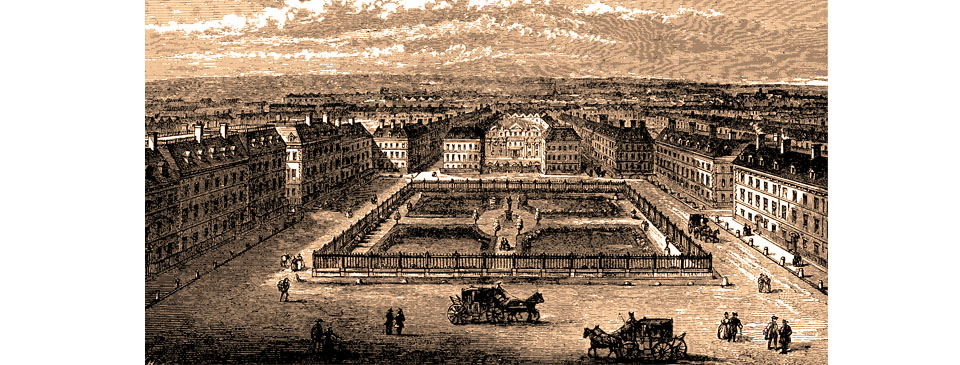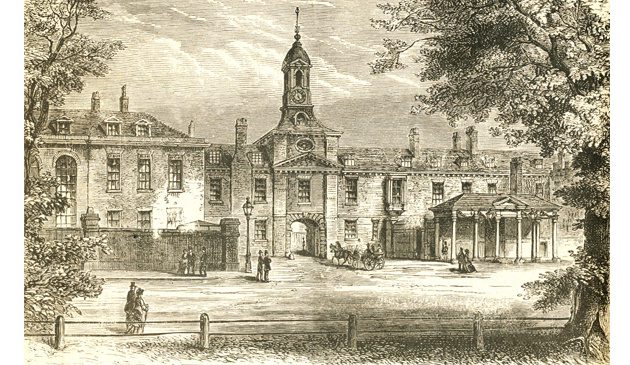The development of Soho

Soho Square in 1700 looking south. It was originally called King’s Square after Charles II whose statue stood in the centre. At the rear of the square in this illustration stands Monmouth House, a mansion completed in 1682 by Sir Christopher Wren for the Duke of Monmouth, the illegitimate son of Charles. He had little time to enjoy his house before he was arrested in 1684 and subsequently executed after staging an unsuccessful coup against his uncle, James II.
Until the 17th century Soho – now one of the busiest areas of Central London – was still a series of open fields. Aristocrat land-owners and property developers gradually transformed it into a suburb that mixed grand homes for the gentry with workshops for artisans.
The development of Soho into a densely-packed suburb occurred between the mid-1670s and the end of the century, from when Golden Square was laid out with houses for aristocrats, gentry and ambassadors. The streets around Wardour Street and Old Compton Street mostly came into being during the 1680s, with many in modern times still retaining the names of developers, land-owners, patrons or prominent people of that period.
During the Middle Ages the area to the north of Charing Cross, then known as St. Giles’s Fields, was held by the Hospital of St. Giles and in 1536, at the dissolution of the monasteries, it came into the ownership of the Crown. It was used as a hunting ground by local gentry who are reputed to have used “soho” as a hunting cry and the whole area gained the name ‘Soho Fields’. A survey of 1650 mentions “a highway leading from Charing Cross towards So Hoe”. The southern part of Soho Fields was gradually acquired from the Crown by the Earl of Leicester. He created Leicester Fields in 1635 when he built a large house for himself on what is now the northern side of Leicester Square.
Over twenty years earlier the tailor Robert Baker had acquired the land north of what is now Piccadilly Circus where he built his Piccadilly Hall that gave the area its name. Inspired by the development of St. James’s to the south west of their land, in 1673 his great-nephews John and James Baker obtained a licence and over the following year or two began laying out a new square. They specifically developed it with the intention of attracting tenants of the aristocratic and gentry classes and in order to do so changed the name from Gelding Close, by which the area had formerly been known, to the more attractive Golden Square. Houses were built of brick and stone, with substantial pavements and adequate sewers. The two brothers fell out regarding the development and each side of the square and the streets that lead into it were created separately. On the west side John employed the bricklayer John Emlyn and named his streets Upper and Lower John Streets while James employed the carpenter James Axtell and his streets on the east are named Upper and Lower James Streets. In the following decades Golden Square became home to peers, army officers and foreign embassies.
In 1661 the Queen Mother, Henrietta Maria, granted the Kemp’s Field and Bunch’s Field sections of Soho Fields – the area in the north-east of the modern Soho – to the Earl of St. Albans. He subsequently sub-leased to the builder Robert Frith who began the development of the area around Soho Square. The first houses were erected in Frith Street and Greek Street in 1680 and by the early 1690s almost all the thoroughfares in that section had been developed, including (Old) Compton, Romilly (originally Church), King and Dean Streets. Fareham and Manette Streets were added during the 1690s.
Soho Square was initially known as King’s Square. From around 1682 the Duke of Monmouth began building an extravagant residence on its south side, where he lived only briefly prior to his execution. In the north east corner stood Fauconberg House, home of the Earl of Fauconberg from 1683 to 1700. (The small mews tucked behind the junction of Oxford Street and Charing Cross Road is still named Falconberg Mews). The Countess of Carlisle resided in a large residence on the west side of the square that gave its name to Carlisle Street.
Many other Soho streets retain their original names from the latter 17th century, reminding us of the entrepreneurs who laid them out, their patrons, or simply well-known people of the time. The two James Streets of Golden Square were laid out parallel to an older thoroughfare to their east that was renamed Bridle Lane after the carpenter Abraham Bridle who developed houses along it in the 1680s. To the north of Golden Square lie Beak Street and Broadwick Street. Beak Street, laid out around 1680, is named after its developer Thomas Beake who later became a servant of Queen Anne. Broad Street was laid out in 1686 but the name was changed in 1936 to Broadwick Street to distinguish it from others of the same name.
Rupert Street was created in 1676 and named after Prince Rupert of the Rhine, nephew of Charles I and one of the Royalist commanders during the Civil War. Compton Street was built up between 1677 and 1683 and named after Henry Compton, Bishop of London, gaining the suffix ‘Old’ in the 1820s. Compton is probably also celebrated in the name of Dean Street, from his time as Dean of the Chapel Royal. Off Dean Street is the small cul-de-sac of Richmond Buildings and Richmond Mews named after the carpenter and former wax-chandler Thomas Richmond who developed them.
Colman Hedge Lane was an ancient byway that ran between the fields of Soho. The area was acquired in 1631 by Sir Edward Wardour, an official at the Exchequer. His grandson Edward developed the area using the services of bricklayer Richard Tyler, plasterer Richard Hopkins and paviour Thomas Green. They are all still remembered in the names Wardour Street and nearby Tyler’s Court, Hopkins Street and Green’s Court.
A yard had been established in 1615 for military training north of Leicester Fields. Charles, Baron Gerard of Brandon seized it in 1661 in a land dispute, with the help of a gang of former soldiers. In the 1680s he leased the ground to Nicholas Barbon who laid out Gerard Street (the modern-day China Town).


